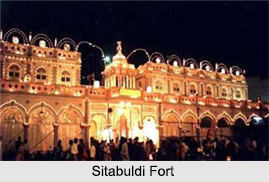 Sitabuldi Fort is located atop a hillock in central Nagpur, Maharashtra. The fort holds significant historical importance as it is site of the Battle of Sitabuldi in 1817. At present, the fort is home to the office of the Indian Territorial Army and is open for public visit during national holidays. This fort is considered to be one of the jewels of Nagpur.
Sitabuldi Fort is located atop a hillock in central Nagpur, Maharashtra. The fort holds significant historical importance as it is site of the Battle of Sitabuldi in 1817. At present, the fort is home to the office of the Indian Territorial Army and is open for public visit during national holidays. This fort is considered to be one of the jewels of Nagpur.
Etymology of Sitabuldi Fort
Tradition holds that Sitabuldi got its call from two Yaduvanshi brothers, Shitlaprasad and Badriprasad Gawali, who ruled the vicinity inside the 17th century. The region came to be referred to as “Shitlabadriâ€, which at some point of British rule have become "Seetabuldee", and later assumed its modern form, "Sitabardi" or "Sitabuldi".
History of Sitabuldi Fort
Sitabuldi Fort was built by Mudhoji II Bhonsle, also known as Appa Sahib Bhosle, of the Kingdom of Nagpur, just before he fought against the British East India Company during the Third Anglo-Maratha War. The fort was built in 1857 by a British officer in memory of the soldiers killed during the Battle of Sitabuldi.
Structure of Sitabuldi Fort
The highlight of the Sitabuldi Fort has a cell where Mahatma Gandhi was imprisoned during India"s freedom movement. Inside the fort, there is a war memorial in dedication to all the soldiers who have died in the war between the Marathas and the British. One can find the graves of those slain soldiers inside the fort. A trench has been created around the fort for its protection. To the south is Nagpur Railway Station and behind it is Tekdi Ganapati, a temple of Lord Ganesha.
Visiting Information of Sitabuldi Fort
Sitabuldi Fort is open to the public only on 15th August and 26th January every year, between 8:00 am and 4:00 pm.



















